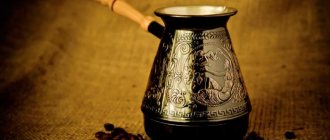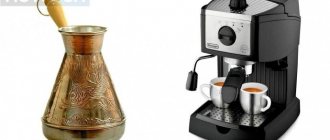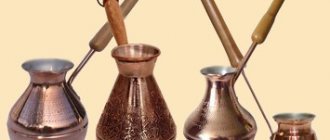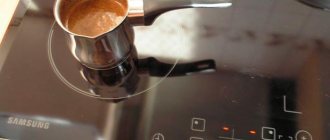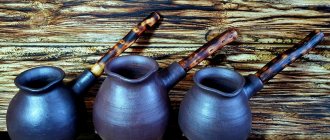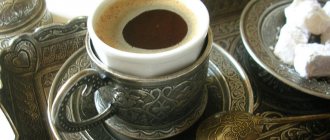There are many devices that make it possible to brew aromatic espresso. Even automated coffee machines have been invented that allow you to prepare a coffee drink with a minimum of effort. At the same time, classic recipes involve the use of cezve and turk. The difference between coffee brewed in such a container is immediately noticeable. It acquires a refined taste and a distinctly noticeable aroma.
History of coffee utensils
They started brewing coffee beans in boiling water about nine centuries ago. Naturally, this required a vessel for making coffee. Then the history of the origin of the utensils for brewing the invigorating drink began.
Initially, unattractive copper pots were used. After this, jugs began to be used, which are called the first predecessors by the Turks. These vessels had a long spout, which made pouring liquid much easier.
The first coffee ladles were round in shape. Their sides were shifted downwards. Due to this, stability was achieved.
Materials
Turks make from materials such as gold, silver, titanium, copper, brass, aluminum, stainless steel. In addition, clay, glass and ceramics also serve as materials for the cezve. Each has its own distinctive characteristics.
Metal Turk: options
The material of the cezve affects the duration of the brewing process and the strength of the coffee. Turks cook faster with metal, but with ceramics they cook longer. The duration of cooking affects the richness, aroma and taste of the drink.
What is Turka
A small vessel used for brewing coffee beans is called a Turka. The distinctive features of this cookware are its wide bottom, thick walls and narrow neck. Her handle is long. The cezve has exactly the same characteristics.
The very name “Turk” was invented by the Russians. Ladles for brewing coffee were brought from Turkey and that is why the Turkish coffee pot was given this name. In addition, the vessel was named this way because the Turkish method of preparing the drink was extremely popular at that time.
Initially, copper was used to make these dishes. There were also products made of aluminum and brass. Nowadays ceramics is a popular material.
What factors influence the taste of Turkish coffee?
You can get a wonderful drink thanks to a successful ensemble of shape and material, but in order to prepare a real masterpiece in the oriental style, such indicators as:
- grain type;
- cooking method;
- amount of powder (the more it is, the richer the finished product);
- seasonings are essential additives that affect taste;
- brewing time - radically changes the density of the extracted substances.
The most difficult task is preserving aromatic oils. They form the coffee film, influence the taste and prepare the receptors for the perception of the magical fragrance. If the foam cannot be preserved as a solid film, this leads to undesirable changes in aroma. The drink turns out bitter. Coffee like
What is a cezve
Cezva means “hot coal” in Turkish. This is the name given to the vessel in which ground coffee beans are brewed. Its external characteristics are no different from the Turks.
Traditionally, these utensils are made of copper, but silver or tin is used for internal processing. This is due to the fact that copper has the ability to form harmful compounds. Therefore, before preparing your favorite drink in a cezve, you need to examine the coating from the inside. If there is damage, the bucket must be replaced.
There are two types of vessels: those made of forged copper and those made of stamped copper.
Stamped ones have thin walls. This affects the quality of the drink, but the price of such products is significantly lower. Forged cezves are considered a traditional option. Their bottom is thick and massive, and their walls are strong. The outside of the ladle is decorated with embossing. This type of utensil has been used to make coffee on sand for many centuries.
Classic Turkish coffee is brewed in a special way. Perform the following actions:
- A baking tray made of metal is filled with pebbles and sand, and then placed on the fire.
- After a few hours, the sand reaches the desired temperature and the cezve is placed on it.
- Brew the drink and immediately set the container aside.
As a result, you can make incredibly aromatic coffee from Arabica or Robusta beans. A similar result cannot be achieved in a coffee machine. Nowadays, however, it is extremely rare to prepare a drink using this method. Most often it is cooked on the stove.
A little history
The vessel with the unusual name ibrik is called the first utensil for brewing coffee. At its core, this is just a beautiful jug. Its long spout is good for pouring hot liquid, and the design itself holds up well to being carried over long distances in bags. Typically, ibriks were not made large - their volume did not exceed 300 ml. But nothing prevented them from being large in size, since they could be used to store water.
They were replaced by dalla . It became popular during the import of coffee to Arabia. In those years, it ceased to be considered a drink of common people and confidently entered the diet of rich people.
That is why the dalla, although it was also an ordinary jug, looked much richer, more picturesque, and more luxurious.
Its main differences were the hammered pattern and the material itself - metal instead of clay. In addition, dalla was used exclusively for coffee, and not for water. Gradually they began to make it in a cone shape, and thus the cezve we got, which we are all accustomed to today.
After some time, another interesting device was invented - a percolator . This is what the inventor (a French priest) named it from the word percolare - “to seep through, penetrate.” The whole structure consisted of two parts and worked quite simply. Ground coffee was poured into the upper bowl, in the walls of which holes were made, and boiling water was poured over it generously. The liquid seeped into the lower container already saturated, that is, in the form of a tasty, invigorating, aromatic drink.
How does a Turk differ from a cezve?
So, ladles designed for brewing coffee are called turks or cezves. In fact, the only difference is in the name. This is the same container, it’s just that its true “name” could not take root in Russia. It seemed very difficult to pronounce. In other countries the name “cezva” is also not always used. It is known in the world as serjep and fainjan.
True, among coffee lovers there are those who are convinced that there is still a difference between these two vessels.
The difference is that the neck of the cezve is significantly narrower and longer. In Turks, the shape of this part is funnel-shaped.
Are cezva and turk the same thing?
In order to get a final answer to the question posed, let’s continue our short journey through time.
Cezva (correctly - cezve) is a traditional utensil for making coffee, common in Turkey and other countries of the Middle East. Made of thick copper, has a long handle. In the original the word is written like this: cezve or gezve.
One version of the origin of the Turkish name is the Arabic word jadhwa (read as “zhedve”). It means "burning coals."
Cezve appeared as an alternative to dalla, which was not very suitable for preparing small portions of coffee. At first we tried using small ladles, but the drink often escaped from them. Therefore, we had to improve the shape of the dishes. This is how the cezve appeared as a separate type of container for preparing small portions of coffee.
Turka . The origin of this word is originally Russian. Turkish merchants arriving in our country on trade business knew that coffee was not common in Rus'. They brought with them supplies of grains, and even utensils for preparing their favorite drink - copper baking sheets and thick-walled small ladles - cezve. Our people called them Turks, based on the nationality of the people who used these scoops. Gradually, coffee entered everyday Russian reality, but for tableware the Turkic name “dzhezve” never took root. It was completely replaced by the word “Turk”, which is more familiar to Russian ears.
What conclusion can be drawn from this linguistic excursion? There is only one thing - there is no difference between a Turk and a cezve. These are national names for the same type of utensils for making coffee - a thick-walled small conical ladle with a thickened bottom, a narrowed neck and a long handle. Different countries have their own names for this item - serjep, fainjan, raka. Russian Turka and Turkish cezve are different names for the same dishes.
What other devices are there for brewing coffee?
There is more than one vessel for brewing coffee. Among the ancient dishes, the following are distinguished:
- irbik;
- dalla;
- ceramic jug;
- percolator
Irbik
Irbik is considered one of the most ancient. This is an Arabic container with a lid. Its neck is narrowed and its base is widened. The jug is also distinguished by the presence of a curved, long handle. It was inconvenient to prepare a coffee drink in such a container over a fire. Therefore, they began to brew coffee in a different container, and Irbik was already used for ordinary water.
Dalla
In the vastness of Syria, a vessel called dalla was popular. This is, in fact, a modified version of irbik. The spout of the ladle is short, and the handle is straight and elongated. The bottom of the container is thick and wide, and the neck is narrow.
The use of dalla became popular when coffee drinks began to be consumed not only by nomads, but also by wealthy people. The dishes looked luxurious. It was decorated with chasing.
Elegant containers were found in the homes of nobles and merchants. Ordinary people were content with simpler versions of these vessels.
The difference between dalla and irbik was the purpose of the jug. The first option was used only for making coffee, while the second could be used to pour various drinks. Archaeologists even managed to find an irbik with a volume of one hundred liters. Naturally, it could not be used to make coffee. Wine or water was poured into such a jug.
Ceramic jug
In France in the eighteenth century, an extraordinary device was invented in which coffee was brewed. It was a jug made of ceramics. A plate resistant to high temperatures was placed on its bottom. Coffee drink lovers used this utensil for a very long period.
Percolator
After some time, the French archbishop invented the percolator. The name of this device comes from the word percōlāre, which translates as “seepage.” The mechanism worked on a simple principle. A vessel with small holes made in the walls was placed in the upper part of the structure and coffee was poured into it. After this, boiling water was poured into the dishes. Thus, in the lower part of the structure there was an invigorating drink.
Turka (aka cezve) is a unique jug that has continued to be used for a huge number of years to obtain an aromatic invigorating drink. Recipes change, different coffee varieties are used, but this tableware remains in demand. Many true coffee lovers do not accept other devices and are convinced that truly aromatic and tasty coffee can only be prepared in such vessels.
How to brew Turkish coffee correctly
In general, “correctly” is not a particularly appropriate word here. There are many ways to brew Turkish coffee; there are many recipes, including those with the addition of various spices for which the Middle East is famous. But one of the classic options looks something like this:
- We take freshly roasted beans of any variety and roast according to your taste. I personally like light-roasted Arabicas, since, given the principle of cooking in a Turk, dark-roasted ones begin to be overly bitter. We grind them “to dust” on any blade (rotary) coffee grinder (the worst, but acceptable option), better - on a good manual one (specialized Turkish Sozen/TimA or just a very high-quality universal, but expensive Commandante C40) or on a serious millstone, preferably with millstones with a diameter of 64 mm and more. Electric ones with smaller millstones (all those cheap conical ones with 38 mm) are poorly suited, unfortunately. You should get an even, smallest possible grind the size of powdered sugar. Turkish coffee is exactly the type of drink for which cheap rotary coffee grinders are better suited than inexpensive millstones.
- Pour 1-2 teaspoons of coffee (7-10 grams) into 70-100 ml of water at room temperature, add sugar and spices to taste, mix. You should not use water, either cooled or heated, this is all from the evil one. If you have a choice of water in terms of mineralization/hardness, then you can safely use the minimum, for example, from a household reverse osmosis filter with a mineralizer - this is usually 60-100 mg/g. Here, for example, is an inexpensive option for home.
- We put the Turk on low heat, the longer it heats up, the better. But there is a limit to everything, more than 5-6 minutes per 250 ml is not worth it, there may be overextraction. Optimal for 100 ml - 3-4 minutes.
- You cannot boil it; the maximum final temperature of the drink is 95 degrees. As soon as the foam has risen to the edges, immediately remove the Turk from the heat.
- Immediately pour all the contents into the cup/cups along with the sediment.
- We are waiting for it to settle and cool down - it is impossible to drink a drink at a temperature of 95 degrees - about 3-5 minutes to taste.
Where is the best place to brew coffee?
Currently, there are quite a few varieties of coffee: granulated, powdered, brewed, whole, ground. Each of them is designed for brewing in one way or another. There is no particular difference in which Turk to choose; they differ only in shape, the material from which they are made, and the ratio of the diameter of the bottom and neck.
If you choose between a coffee maker and a cezve, there are a number of pros and cons. True connoisseurs of Americano choose the manual method of cooking, which results in an individual taste.
True connoisseurs of Americano choose the manual method of cooking, which results in an individual taste.
Coffee ground 15 minutes before cooking has the full range of taste and aroma qualities.
A significant plus is the price; a Turk is several times cheaper than a coffee machine and takes up much less space in the kitchen. Of course, it is easier to care for a cezve than a whole coffee-making apparatus.
A Turk is several times cheaper than a coffee machine and takes up much less space in the kitchen.
The downside is time; cooking in Turkish requires skills and constant supervision, otherwise the coffee tends to run out onto the tile or be spoiled. The manual method is not suitable for large companies; it only takes a couple of servings. Another feature of the cezve is that it is not suitable for most stoves; a special adapter for the induction surface and a diffuser for gas burners are required.
Aluminum cezves
Aluminum Turks are inexpensive and in demand. However, such coffee makers cannot be compared with copper ones. Heating and cooling in them occurs quickly and unevenly. This is only convenient if you are going on a hike.
Advantages:
- ease;
- quality factor,
- cheapness.
Flaws:
- aluminum reacts with coffee acids, creating compounds with a metallic unpleasant aftertaste;
- Due to the softness of the metal, the surface of the product is easily damaged
- Due to its light weight, the coffee maker is unstable
- aluminum produces an irregularly shaped vessel
- The porous structure of aluminum absorbs and retains aroma. This is bad when brewing a variety of coffees.
- An aluminum coffee maker darkens and becomes unattractive over time.
Brass cezves
Brass is a multi-component or two-component copper-based alloy, the alloying element of which is zinc. Metals such as tin, iron and aluminum are also added to brass. It is considered a good material for the production of Turks. Due to its more rigid property, heating occurs much more slowly. The inside is covered with a layer of food grade tin. Excellent polished metal and well decorated with embossing and patterns.
Features of brass Turks
Brass cezves are harder and have a thicker wall.
In order not to confuse brass with copper, we must take into account that copper is much more expensive. They are also different colors: copper is redder, brass is yellower. The amount of zinc in the alloy gives a more yellow tint.
Advantages
- availability;
- thermal conductivity properties;
- variety of shapes
- presentable;
- strong and durable;
- suitable for frequent use;
- heating the drink more evenly and more slowly.
Flaws:
- the inner protective layer of tin requires more delicate care;
- damage to the tin coating leads to severe oxidation of the brass;
- brass is more fragile, shocks and falls are not allowed.
Dalla
Dalla is a Middle Eastern coffee pot that replaced the ibrik. The shape of the dalla resembles an onion: a jug with a wide bottom and rounded sides that sharply tapers towards the top. The groove on the neck turns into a long curved spout, reminiscent of a bird's beak. To keep the coffee warm longer, close the jug tightly with a lid.
Rice. 5. Dalls with round handles
Rice. 6. Dalla with straight handle
Dalla is still popular in the Middle East. As in ancient times, the vessel is made of brass, steel, for the rich - from silver or gold, decorated with carvings and ivory overlays. The dalla can have a round (Fig. 5) or straight handle.
Rice. 7. 74-year-old Ismail Ali Al-Hassan (the last master in the UAE who makes dallahs by hand) engraves a vessel made of 24-karat gold at the request of one of the sheikhs
Glass coffee maker: quartz glass Turks
Glass Turks for brewing coffee heat up quickly. In transparent vessels it is interesting to observe the process and control the foam. It is not difficult to remove the Turk from the fire in time.
Advantages:
- harmlessness;
- You can prepare different drinks: tea, decoctions and cocoa.
Flaws:
- short-lived and fragile;
- temperature changes are contraindicated;
- poor quality coffee.
